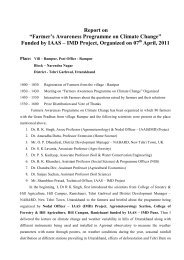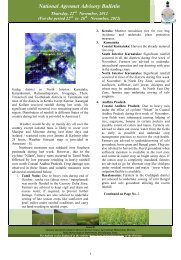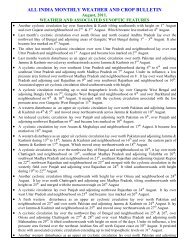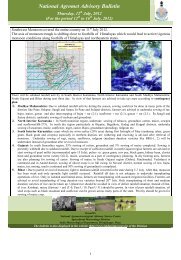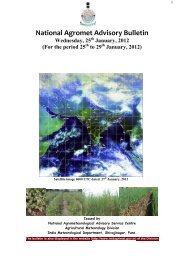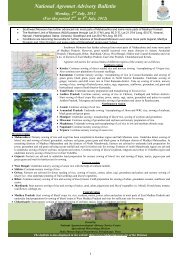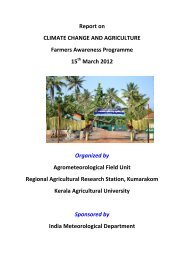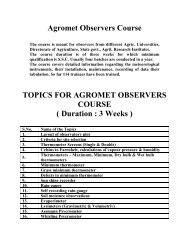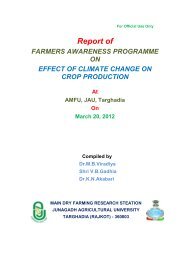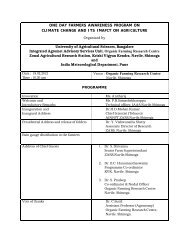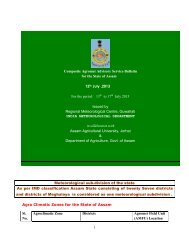English - Agricultural Meteorology Division
English - Agricultural Meteorology Division
English - Agricultural Meteorology Division
You also want an ePaper? Increase the reach of your titles
YUMPU automatically turns print PDFs into web optimized ePapers that Google loves.
AGROMETEOROLOGICAL SERVICES IN INDIA<br />
<strong>Agricultural</strong> <strong>Meteorology</strong> <strong>Division</strong><br />
Weather and Agriculture<br />
Indian agriculture has, for centuries, been solely dependant<br />
on the weather and the vagaries of the monsoon in particular.<br />
Uncertainties of weather and climate pose a major threat to<br />
food security of the country. Extreme weather events like<br />
heavy rains, cyclone, hail storm, dry spells, drought, heat<br />
wave, cold wave and frost causes considerable loss in crop<br />
production every year. An efficient use of available climatic<br />
resources, besides soil & water resources, minimizes the<br />
adverse effect of extreme weather and makes benefit of<br />
favourable weather. Weather services provide a very special<br />
kind of inputs to the farmer as advisories that can make a<br />
tremendous difference to the agriculture production by taking<br />
the advantage of benevolent weather and minimize the<br />
adverse impact of malevolent weather.<br />
Government of India<br />
Ministry of Earth Sciences<br />
India Meteorological Department<br />
Collaborating agencies under IAAS<br />
<strong>Agricultural</strong> <strong>Meteorology</strong> <strong>Division</strong>,<br />
India Meteorological Department, Pune<br />
Weather Service to Agriculture<br />
<br />
<br />
<br />
<br />
<br />
State <strong>Agricultural</strong> Universities (SAU)<br />
Indian Council of <strong>Agricultural</strong> Research (ICAR) and its<br />
Research Institutes<br />
Indian Institute of Technology<br />
State and Union Departments of Agriculture<br />
Prasar Bharati and other media (Radio, TV and Print)<br />
In order to provide direct services to the farming community<br />
of the country an exclusive <strong>Division</strong> of <strong>Agricultural</strong><br />
<strong>Meteorology</strong> was set up in 1932 under the umbrella of India<br />
Meteorological Department (IMD) at Pune with the objective<br />
to minimize the impact of adverse weather on crops and to<br />
make use of favourable weather to boost agricultural<br />
production.<br />
The major activities of the <strong>Division</strong> are:<br />
• Technical Assistance<br />
• Research & Development<br />
• Services<br />
• Human Resource Development<br />
Network of Observatories<br />
The <strong>Division</strong> of <strong>Agricultural</strong> <strong>Meteorology</strong> maintains and<br />
provides technical support to a wide range of Agromet<br />
Observatories from where different kinds of data on agromet<br />
parameters are generated.<br />
Integrated Agromet Advisory Services<br />
To meet the farmer’s need in real-time and to have a state-ofart<br />
Agromet Advisory Service (AAS), Integrated Agromet<br />
Advisory Service in the country involving all the concerned<br />
organizations viz., Indian Council of <strong>Agricultural</strong> Research<br />
(ICAR), Ministry of Agriculture (Centre & State), State<br />
<strong>Agricultural</strong> Universities (SAUs) and other agencies has been<br />
started from April 2007.<br />
Central <strong>Agricultural</strong> Meteorological Observatory (CAgMO)
IMD’s Central <strong>Agricultural</strong> Meteorological Observatory located<br />
at Pune, is equipped with a wide range of instruments for<br />
measurement of agrometeorological parameters like<br />
evaporation, soil temperature, soil moisture, radiation fluxes,<br />
dew, microclimatic profiles, besides routine meteorological<br />
observations. The observatory also serves as the testing<br />
ground for new instruments and experimental techniques.<br />
There are 264 agromet observatories in the country to record<br />
agrometeorological parameters.<br />
Pan Evaporimeter<br />
Evapotranspiration (ET) in<br />
plant environment is measured<br />
by means of lysimeters at 42<br />
stations. This helps to<br />
determine the water<br />
requirements of crops. There<br />
are 9 volumetric and 33<br />
gravimetric ET observatories.<br />
219 USA open pan evaporimeters<br />
are installed to record evaporation.<br />
Lysimeter<br />
Types of AAS Bulletins<br />
AAS Bulletins are issued from three levels:<br />
National Levels by National Agromet Advisory Service<br />
Centre, Agrimet <strong>Division</strong>, IMD,Pune.<br />
State Levels by State Agromet Service Centre at Regional<br />
Meteorological Centre/Meteorological Centre (23)<br />
District Level by Agromet Field Units (130)<br />
District level Agromet Advisory bulletins are issued for the<br />
farmers, State Level Composite AAS Bulletins are for State<br />
level planners e.g. State Crop Weather Watch Group (CWWG)<br />
and other users like Fertiliser industry, Pesticide industry,<br />
Irrigation Department, Seed Corporation, Transport and other<br />
organisations which provide inputs in agriculture and National<br />
Agromet Advisory Bulletin are primarily targeted for national<br />
level planners e.g. CWWG, Department of Agriculture &<br />
Cooperation, Ministry of Agriculture, New Delhi and also<br />
communicated to all the related Ministries (State & Central),<br />
Organizations, NGOs for their use.<br />
Network of stations under IAAS<br />
There are 43 soil moisture recording stations. Soil moisture at<br />
different depths (7.5, 15, 30, 45, 60 cm) of the soil is recorded<br />
from 43 stations to formulate irrigation scheduling of crops.<br />
Dew Gauge<br />
Beside rainfall, dewfall is one of<br />
secondary source of moisture<br />
available to the crops. It plays<br />
significant role in plant growth<br />
particularly in arid and semi arid<br />
regions. Total 76 stations are<br />
recording dew observations.<br />
The data recorded in the above mentioned observatories are<br />
being utilized for operational services such as advising the<br />
farmers through Agromet Advisory Services. Besides a<br />
number of organizations utilize the data for research, irrigation<br />
and water resources planning, management of drought, flood<br />
etc.<br />
Network of SMC UNITS(23)<br />
It is proposed to install 127 Agrometeorological Automatic<br />
Weather Stations (AWS) at Agrometeorological Field Units<br />
(AMFU’s) located at State Agriculture Universities (SAUs),<br />
institutes of Indian Council of Agriculture Research (ICAR),<br />
Indian Institute of Technology under Integrated Agromet<br />
Advisory Services (IAAS). Installation of Agro-AWS is also<br />
under consideration in all the Krishi Vigyan Kendras (KVK) in<br />
the country.<br />
Network of AMFU STATIONS(130)<br />
Main features of AAS bulletin :<br />
Significant past weather<br />
Quantitative weather forecast for next five days.<br />
Advisories for farming community<br />
AWS at Mailam (Tamil Nadu)<br />
2<br />
Joint Meeting at SAMC for preparation of State Composite bulletin
Broad Spectrum of Agromet Advisories<br />
Sowing/ transplanting of kharif crops based on onset of<br />
monsoon<br />
Sowing of rabi crops using residual soil moisture<br />
Fertilizer application based on wind condition<br />
Delay in fertilizer application based on intensity of rain<br />
Prediction of occurrence of pest and disease based on<br />
weather<br />
Propylactive measures at appropriate time to eradicate pest<br />
and diseases<br />
Weeding/Thinning at regular interval for better growth and<br />
development for crop.<br />
Irrigation at critical stage of the crop.<br />
Quantum and timing of irrigation using meteorological<br />
threshold.<br />
Advisories for timely harvest of crops<br />
District Level AAS based on Medium Range<br />
Weather Forecast<br />
IMD has started issuing quantitative district level (612<br />
districts) weather forecast upto 5 days from 1 st June, 2008.<br />
The products comprise of quantitative forecasts for 7 weather<br />
parameters viz., rainfall, maximum and minimum<br />
temperatures, wind speed and direction, relative humidity and<br />
cloudiness. In addition, weekly cumulative rainfall forecast is<br />
also provided. IMD, New Delhi generates these products<br />
based on a Multi Model Ensemble technique using forecast<br />
products available from number of models of India and other<br />
countries. These include: T-254 model of NCMRWF, T-799<br />
model of European Centre for Medium Range Weather<br />
Forecasting (ECMWF); United Kingdom Met Office (UKMO),<br />
National Centre for Environmental Prediction (NCEP), USA<br />
and Japan Meteorological Agency (JMA).<br />
The products are disseminated to Regional Meteorological<br />
Centres and Meteorological Centres of IMD located in<br />
different States. These offices undertake value addition to<br />
these products and communicate to 130 AgroMet Field Units<br />
(AMFUs). It is proposed to prepare and publish the AAS<br />
bulletins for all the districts by December 2009.<br />
The district level agromet advisory service is multidisciplinary<br />
and multi-institutional project. For this, IMD organized District<br />
Agromet Advisory Service meeting in each of the state of the<br />
country inviting the officers/ scientists and all the stakeholders<br />
with objectives to create appropriate information generationcum-dissemination<br />
mechanism as well as extension<br />
mechanism at district level for communicating the agromet<br />
advisory to the farmers.<br />
Dissemination of Advisories<br />
Dissemination of Agromet advisories is done through:<br />
1. All India Radio (AIR) and Doordarshan<br />
2. Private TV and radio channels<br />
3. Newspaper<br />
4. Internet<br />
5. ICAR and other related Institutes / <strong>Agricultural</strong> Universities /<br />
Extension network of State / Central Agriculture Departments<br />
6. Krishi Vigyan Kendras<br />
7. Advisories are delivered to the end users without any delay.<br />
8. Interactive tuning of advisories with the farmers / managers as<br />
frequently as possible.<br />
9. It is disseminated in <strong>English</strong> and local languages / dialects and<br />
is easily understandable by farmers.<br />
Outreach of advisories at District/Block/Village level<br />
Linkages between Districts <strong>Agricultural</strong> Offices (DAOs) and<br />
AMFUs level are being developed for effective dissemination of<br />
advisories at district, block and village levels.<br />
Extension of Advisories<br />
Extension wing of the State Departments of Agriculture, State<br />
<strong>Agricultural</strong> Universities, Indian Council of <strong>Agricultural</strong><br />
Research Institutes are working for application of the advisories<br />
in the farmer’s fields.<br />
3
Feedback & Awareness of Agromet Service<br />
In order to improve the quality of the agromet advisory services,<br />
regular direct interactions are being made by the AMFUs with the<br />
farmers, AMFUs, State AAS units and Agrimet <strong>Division</strong> are<br />
regularly participating in Kisan Melas farmer’s gathering etc to<br />
interact with the farmers personally and collect the feedback from<br />
farmers. Roving seminars are being organized in different States<br />
by AMFUs to create awareness about usefulness of<br />
weather/climate information, agromet advisory services among the<br />
farming community.<br />
Crop Yield Forecasting<br />
A need for quantitative crop yield forecast outlooks has been felt<br />
for quite sometime. A beginning towards its realization has been<br />
made by undertaking a study of past crop yield in relation to<br />
meteorological parameters, principally rainfall and temperature.<br />
Based on these studies quantitative crop yield forecast formulae<br />
have been developed for 22 sub divisions in the country for<br />
kharif rice and 9 sub divisions for wheat. The tentative forecast<br />
for crop yield is being issued every month during the crop<br />
season using this methodology.<br />
Research & Development<br />
From the inception the Agrimet <strong>Division</strong> is working on research<br />
and development programmes to strengthen the operational<br />
agrometeorological services in the country.<br />
Microclimatic Study<br />
The study of microclimate of crops was one of earliest<br />
investigation to be taken by the <strong>Agricultural</strong> <strong>Meteorology</strong> <strong>Division</strong><br />
in Pune since 1932. The subject of micro-climates received<br />
intensive attention and significant contributions have been made in<br />
this field of research. Research activity in the field of<br />
microclimatology was carried out extensively by various personnel<br />
from IMD as well as others. Systematic observations on the<br />
characteristic micro-climates of the air layers close to the ground<br />
in the open and inside various crops have been recorded, and a<br />
large volume of micro-climatological data collected.<br />
Agroclimatic Classification<br />
In order to bring out agricultural potential of a region, its<br />
agroclimatic classification has to be made Considerable work has<br />
been done on agroclimatic classification. Agroclimatic zones have<br />
been delineated using Thornthwaite moisture availability index<br />
and other methods. Penman method has been used to estimate<br />
evapotranspiration of about 230 stations located in India. These<br />
estimates are used to compute water balance of these stations in<br />
India and ultimately agroclimatic classification.<br />
Adverse weather phenomena<br />
The <strong>Agricultural</strong> <strong>Meteorology</strong> <strong>Division</strong> has made a detailed<br />
examination and prepared suitable diagrams of the<br />
frequencies of occurrence of various adverse weather<br />
phenomena (like hail storms, frosts, etc.) that affect growing<br />
crops, extremes of temperature met with in summer and<br />
winter, estimated evaporating power of the atmosphere etc.<br />
Such diagrams help to show how often the farmer may be<br />
called upon to mitigate the effects of adverse weather<br />
phenomena by resorting to possible protective measures like<br />
artificial heating, use of wind brakes etc.<br />
Vine affected by frost<br />
at Nasik<br />
Wind break of jowar stalks<br />
in vine garden<br />
Cropping patterns<br />
By analyzing the rainfall records of 2000 stations for 70 years, the<br />
periods and amounts of “assured rainfall” have been worked out<br />
for various regions particularly in the dry farming tract of India. The<br />
length of dry spells and wet spells during the monsoon, drought<br />
proneness and agro-climatic classifications have also been<br />
studied with climatological data. This information is helpful in<br />
choosing appropriate crops for various regions, determining the<br />
most favourable growing seasons for rainfed crops and selecting<br />
drought tolerant crop strains.<br />
4
Sowing dates<br />
Optimum dates for sowing have been determined for the States of<br />
Maharashtra, Rajasthan, Gujarat and Madhya Pradesh, by using<br />
daily rainfall data from 1901 onwards. Such information helps in<br />
deciding the best period for sowing operations, water conservation<br />
measures and evolution of appropriate cropping patterns.<br />
Water use management<br />
Considerable research has been done on the weather conditions<br />
conducive to outbreaks of crop pests and disease like paddy<br />
stem borer, jowar shoot fly, cotton bollworm, sugarcane borers,<br />
groundnut tikka, potato beetle and wheat rusts. The results help<br />
to organize timely crop protection measures with optimum use of<br />
expensive chemicals. The desert locust breeding and invasion<br />
has been extensively studied in relation to soil and weather<br />
conditions.<br />
Drought Studies<br />
Even in those parts of the country where irrigation facilities exist,<br />
the crop production can be maximized by better scheduling of<br />
irrigation. Scarce resources can be economically used by providing<br />
water to crops when it is known to be most beneficial. For this,<br />
precise water requirements of crops at various growth stages are<br />
being studied through field experiments and regular lysimeter<br />
measurements of evapotranspiration.<br />
Remote sensing applications<br />
Satellite remote sensing techniques have been used for acreage<br />
estimation of jowar. Spectral response of crops at various growth<br />
stages and states are studied to help crop identification. Soil<br />
moisture studies using micro-wave remote sensing technique were<br />
made.<br />
By analyzing rainfall data since 1875, the probability of<br />
occurrence of drought in various parts of India has been worked<br />
out. Different parameters like water availability, soil moisture<br />
stress, aridity index have been studied. Droughts are monitored<br />
by deriving aridity anomalies on a fortnightly basis in the kharif<br />
season and weekly basis in the northeast monsoon season over<br />
the southern peninsula.<br />
Crop weather analysis<br />
Theoretical models of crop weather relationship enable to<br />
understand, quantitatively, the role played by weather elements on<br />
crop growth and yield. Variability of soil moisture and soil<br />
temperature and the contribution of dew have been studied in<br />
relation to crop growth. Fluctuations in weather with regard to crop<br />
factors like leaf area index, stomatal resistance, crop coefficient,<br />
and dry matter production have been studied. Energy balance of<br />
the crop canopy for cereals and legumes are being worked out. A<br />
number of crop weather calendars were prepared based on crop<br />
weather studies. Crop growth simulation models (DSSAT) are<br />
being used to develop crop weather relation as well as crop yield<br />
forecasting.<br />
Crop protection<br />
Dry Land Farming<br />
The area having annual rainfall between 40-100 cm and<br />
practically with no irrigation facilities is known as dry farming<br />
tract. Dry farming tract comprise 87 districts and is spread over<br />
Haryana, Punjab, Rajasthan, Gujarat, Uttar Pradesh, Madhya<br />
Pradesh, Maharashtra, Andhra Pradesh, Karnataka and<br />
Tamilnadu. Extensive research was carried out on assessment<br />
of short period rainfall probability, compilation of frequency,<br />
duration and intensity of dry and wet spells, assessment and<br />
seasonal and diurnal variation of meteorological parameters,<br />
derivation of agroclimatic zones and sub-zones.<br />
Pest Observation in experimental fields of <strong>Agricultural</strong> University<br />
5
Training Programmes in the <strong>Division</strong><br />
Following training programmes for national and international<br />
training for Agromet Observers, University Teachers /<br />
Departmental officers & foreign personnel are regularly<br />
arranged in the <strong>Division</strong>.<br />
Delineation of zones (A, B, C, D) of similar peak rainfall period and<br />
areas (I, II, III) of average rainfall receiving during the period.<br />
Weather and Phenology of Crops<br />
Phenology is the science which deals with the recurrence of<br />
the important phases of animal and vegetable life in relation<br />
to the march of seasons during the year. The dates of<br />
manifestation of phytophase constitute an integral of climatic<br />
effects as they take into account the weather over past<br />
periods and also the weather at the moment. Studies were<br />
made to observe the effect on climatic factors on the<br />
flowering, fruiting and maturity of four trees i.e., mango,<br />
neem, tamarind and babul. The observations were taken<br />
about 200 phenological stations located in the <strong>Agricultural</strong><br />
Farms, Soil Conservation Centre and Meteorological<br />
Stations.<br />
Agrometerorological observations with state of art<br />
instruments<br />
A number of experiments using portable photosynthesis system,<br />
infra-red thermometer, portable leaf area meter, dew point<br />
generator and dew point microvoltmeter were conducted at<br />
College of Agriculture, Pune during rabi season on impact of CO 2,<br />
photosynthetically active radiation (PAR), temperature and relative<br />
humidity on the rate of photosynthesis and other parameters like<br />
transpiration, stomatal conductance, etc., in field crops like maize,<br />
jowar, safflower, sunflower, mustard and soybean<br />
1. Foreign Trainees’ course of 6 months duration.<br />
2. Agromet Core course of 3 weeks duration for teachers &<br />
scientists of <strong>Agricultural</strong> Universities / Institutes.<br />
3. Observers course of 3 weeks duration for recording<br />
observation.<br />
4. Departmental Trainees (Grade ‘A’ officers) – courses of 10<br />
months duration in <strong>Agricultural</strong> <strong>Meteorology</strong>.<br />
5. On the job training for advanced(revised) meteorological<br />
course trainees<br />
6. Basic Agromet course of 3 weeks for Departmental<br />
candidates<br />
7. Refresher course of 2-3 weeks for Departmental/non –<br />
departmental Officers<br />
So far 729 Agromet Observers, 43 University Teachers /<br />
Departmental officers & 72 foreign personnel have been<br />
trained in <strong>Agricultural</strong> <strong>Meteorology</strong>.<br />
Future Programme<br />
Proposed modes of dissemination<br />
Dissemination through Common Service Centres (CSC) by<br />
DIT<br />
1. Department of Information Technology (DIT) is planning to<br />
develop ICT facilities for the benefit of the citizens, especially<br />
those in rural & remote areas. 1,00,000 CSC will be set up at<br />
village level shortly to provide all possible services. Among<br />
others, Agromet services will also be provided through the<br />
CSCs.<br />
2. Ministry of Agriculture is already operating "<strong>Agricultural</strong><br />
Technology Management Agency (ATMA)" project in several<br />
districts on the line of NGO concept.<br />
Observation with leaf Area<br />
Meter<br />
Dew Point Generator<br />
Dew Point Microvoltmeter<br />
Microvoltmeter<br />
3. It is also planned to provide AAS link to Village Knowledge<br />
Centers at taluka level that have already been opened by<br />
M.S. Swaminathan Research Foundation & Alliance for<br />
providing the need based information at village level.<br />
4. Under Integrated Agromet Advisory Service (IAAS)<br />
scheme, IMD is exploring to tie up with different public and<br />
private organizations to use IVR and SMS technology which<br />
are already working in dissemination of agricultural<br />
information to the rural village.<br />
6
Fasal Project<br />
Crop yield forecasting under FASAL (Forecasting <strong>Agricultural</strong><br />
output using Space, Agrometeorology and Land based<br />
observations) project with greater accuracy in collaboration with<br />
Department of Space & Department of Agriculture and<br />
Cooperation is proposed to be implemented with the following<br />
objectives.<br />
Development of national / state / district level multiple crop<br />
yield forecast for major crops.<br />
Crop yield forecast would be issued at mid season (F1) and<br />
pre-harvest stages (F2) of crop<br />
A number of crop yield forecast models would be developed<br />
and made operational after validation<br />
Generation of Agromet products<br />
Efforts are on to make agromet advisory more users’ oriented and<br />
adequate steps are being taken to develop customized<br />
information and service to the farmers. Special initiative has taken<br />
to generate agromet products for pesticides application fertilizer<br />
application, application of Irrigation etc. from weather, crop, soil,<br />
remote sensing data etc. using GIS platform and high power<br />
computing system. The project is being implemented in<br />
collaboration with Met France International (MFI)<br />
Economic Impact of AAS<br />
Department of Science & Technology (DST) launched a project in<br />
2003 to study the Economic Impact of AAS of NCMRWF. The<br />
project was given to 15 AAS units Duration was 3 years covering<br />
3 kharif and 3 rabi seasons. National Centre for <strong>Agricultural</strong><br />
Economics & Policy Research (NCAP) was given consultancy for<br />
preparing concept note, questionnaire, methodology and final<br />
review of the reports prepared by the AAS unit/NCMRWF. It is<br />
observed that farmers could save significant loss of crop and<br />
made their farming profitable by using the AAS. It is being<br />
planned to extend such studies for more number of years and<br />
more number of stations under IAAS.<br />
Network of stations that carried out the Economic Impact study<br />
Generation of Advisories for New Sectors<br />
A large number of farming systems are not adequately addressed<br />
by the existing AAS. Hence, there is a strong need to develop<br />
suitable products for these sectors and incorporate them in the<br />
advisory bulletins. Advisory for Horticultural Crops, livestock,<br />
wasteland and forest fires, post harvest and storage.<br />
Establishment of fast communication system<br />
It is proposed to create a state of art telecommunication system<br />
for inter-linking National HQ of Agro-met Advisory Services with<br />
SAMC, AMFUs. The telecommunication system will be capable to<br />
transfer imageries, weather charts, products and bulletins in all<br />
weather situations. It is proposed to include Virtual Private<br />
Network (VPN) Service in the present system. The VPN is<br />
capable to allow free flow of information and quick data transfer.<br />
Launching of comprehensive programme on R & D<br />
Department of Science & Technology (DST) had been funding<br />
research projects in Agrometeorology with focus on crop-weather<br />
modeling, impact of climate variations and change on agriculture<br />
and also in support of weather-based agromet advisory services.<br />
After the formation of Ministry of Earth Sciences (MoES), this<br />
programme has now been transferred from DST to MoES/IMD.<br />
The scheme would be operated in different phases in IMD as well<br />
as collaborating organizations/institutes.<br />
Being the nodal office IMD would give projects to different<br />
agricultural universities/institutes and in turn the outputs of the<br />
study would be used for generation of agromet products for the<br />
crop and location specific agromet advisories<br />
Proposed Training for Agromet Advisory Services<br />
A number of training programmes will be organized for those who<br />
are directly and indirectly involved in the AAS’ These are:<br />
1. Weather forecast based AAS to Technical Officers<br />
2. Crop/ P&D models and Decision Support System<br />
3. NWP based local weather forecast techniques<br />
4. Use of Remote Sensing and GIS in AAS<br />
5. Outreach Programme<br />
6. Provision of adequate training for the end-users<br />
Agri-insurance<br />
The weather is the greatest adversary as farmers face floods,<br />
drought, pests, disease, and a plethora of other natural disasters<br />
while raising the crops. Crop insurance, which has been<br />
functioning for quite some time in India, is a risk management tool<br />
that farmers can use. The sector is still evolving and not highly<br />
developed. Hence, there is scope for further improvement. Efforts<br />
are being made to generate meteorological requirements for agriinsurance<br />
in consultations with the concerned organizations.<br />
Organisation of Roving Seminars<br />
It is proposed to organize one day Roving Seminar on Weather,<br />
Climate and Farmers in different agro-climates of the country to<br />
sensitize farmers about the weather and climate information and<br />
it’s applications in operational farm management. The seminar is<br />
proposed to be organized jointly by India Meteorological<br />
Department (Ministry of Earth Sciences), Indian Council of<br />
Agriculture Research and State <strong>Agricultural</strong> Universities. Local<br />
NGOs and other stake holders may also be roped in this occasion<br />
depending upon the local needs and interests.<br />
7
Use of Remote Sensing techniques in preparation of<br />
Agro-met Advisory<br />
It is of utmost importance to enhance the quality and usefulness<br />
of the agro meteorological services utilizing the data received<br />
from Remote Sensing Satellite like IRS. Many agencies viz.,<br />
Space Applications Centre (SAC), Ahmedabad, National Remote<br />
Sensing Agency (NRSA), Hyderabad etc., have developed<br />
techniques based on Remote Sensing for crop acreage and yield<br />
estimation, crop condition assessment of major crops and<br />
assessment of drought conditions in some selected states during<br />
kharif season. It is proposed to use remote sensing data in<br />
agromet service through collaboration with Department of Space.<br />
Technical Assistance<br />
The <strong>Agricultural</strong> <strong>Meteorology</strong> <strong>Division</strong> has been providing<br />
assistance to various <strong>Agricultural</strong> Universities & State<br />
Departments of Agriculture & <strong>Agricultural</strong> Research Institutes to<br />
set up a Agrometeorological Observatory within the agricultural<br />
farm by way of selection of sites, testing & standardization,<br />
installation, repairing & periodical inspection of meteorological<br />
instruments.<br />
The collaborating universities/institutes supply the Agromet data to<br />
IMD. Data received from Agromet Observatories are scrutinized,<br />
tabulated & transferred on magnetic tapes for archival. The same<br />
are being supplied to the research workers & other interested<br />
parties as & when requisitioned.<br />
Publication<br />
The <strong>Division</strong> has brought out following nine publications.<br />
1. Weekly Rainfall Probability for Selected Stations of India<br />
(Vol.I and II):<br />
2. Crop Weather Calendars<br />
3. Weekly Potential Evapotranspiration over India:<br />
4. Dew Deposition over India<br />
5. Normals of Agroclimatic Observatories in India<br />
6. Evaporation Maps of India<br />
7. Agroclimatic Atlas of India<br />
8. Evapotranspiration<br />
9. Evaporation Data of Observatories in India<br />
Besides, there are about 500 research papers published from this<br />
<strong>Division</strong> in National and International Journals.<br />
Editorial Team :<br />
Dr. L. S. Rathore, Dr. R.P. Samui, Dr. N. Chattopadhyay<br />
Published by<br />
<strong>Agricultural</strong> <strong>Meteorology</strong> <strong>Division</strong>, India Meteorological Department, Shivajinagar, Pune – 411 005.<br />
Tel. Fax : (020) 25535953 / 25512022 / 25512023<br />
Website : www.imdagrimet.gov.in<br />
Emails : agrimet_pune@yahoo.com and agrimet_information@yahoo.com<br />
8



